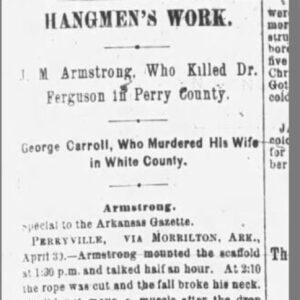calsfoundation@cals.org
George Carroll (Execution of)
George Carroll, convicted of drowning his wife, was hanged at Searcy (White County) on April 30, 1886, one of two Arkansans to die on the gallows that day.
George Carroll, who “bears a hard name” in his hometown of Beardstown, Tennessee, by 1885 was living on a farm about ten miles north of Searcy with his wife Lizzie, their two children, and his half brother’s widow Vina (or Vinia) Tidwell, who would help the twenty-five-year-old Carroll with farmwork as his wife kept house.
Carroll and Tidwell became “so intimate that he decided to murder his wife to get rid of her.” He originally plotted to kill Lizzie Carroll, described as “a highly educated lady, and an earnest, industrious wife,” by asking her to help him build a chimney, planning to knock her ladder over and kill her with a stone, making it look like an accident. A neighbor happened to come by and helped Carroll with the chimney, foiling his plan.
On February 1, 1885, Carroll told Tidwell that he would kill his wife the next day by drowning her in a well and that she should find the body after he left to work on the farm. The next morning, Tidwell later testified that “when she heard Carroll call her [his wife] out to the well she threw herself on the bed and covered her ears, that she might not hear the death cries.”
Tidwell “discovered” the body, but she and Carroll were immediately suspected in the death, as Lizzie Carroll’s “body bore evidence of a deadly struggle. The clothing was torn, and the top of the head badly bruised.” Both were arrested, and “a lynching of Carroll was barely averted by the officers who had him in custody.”
Carroll was tried in June 1885, and Tidwell turned state’s evidence and testified against him. He was found guilty of throwing his wife into the well and then holding her down with a stick until she drowned. Convicted of first-degree murder, he was sentenced to hang in September 1885, which was delayed while he appealed his conviction. The Arkansas Supreme Court affirmed his sentence in January 1886.
Several people contacted Governor Simon Pollard Hughes and asked him to commute Carroll’s death sentence, but he declined, saying that if anyone deserved to hang, Carroll “should be placed on the list.” He set April 30, 1886, as the execution date. Carroll escaped from the White County jail on April 24 but was captured two days later.
Carroll was taken from the jail at 12:30 p.m. on April 30 and transported to the execution site a mile away. He made a full confession from the gallows, and the “the preliminaries were quickly arranged and the trap sprung. Death ensued in a few minutes.”
J. M. Armstrong, convicted of murdering a doctor, was also executed on April 30, 1886, being hanged at Perryville (Perry County).
For additional information:
“Full Details of the Arkansas Murder.” Kansas City [Missouri] Star, April 30, 1886, p. 1.
“Hangmen’s Work.” Arkansas Gazette, May 1, 1886, p. 1.
“Legally Strangled.” St. Louis [Missouri] Post-Dispatch, April 30, 1886, p. 1.
“Opinion by Battle, J.” Daily Arkansas Gazette, January 10, 1886, p. 2.
“Put Out of the Way.” St. Louis [Missouri] Globe-Democrat, February 25, 1885, p. 4.
“Recaptured.” Arkansas Democrat, April 26, 1886, p. 8.
“Time to Be Set.” Arkansas Democrat, March 29, 1886, p. 4.
“To Be Hanged.” Arkansas Democrat, April 10, 1886, p. 4.
Untitled. Russellville Democrat, May 5, 1886, p. 2.
“Will Hang.” St. Louis Post-Dispatch, June 30, 1885, p. 1.
Mark K. Christ
Central Arkansas Library System
 Law
Law Post-Reconstruction through the Gilded Age, 1875 through 1900
Post-Reconstruction through the Gilded Age, 1875 through 1900 Armstrong and Carroll Execution Story
Armstrong and Carroll Execution Story  George Carroll Execution Story
George Carroll Execution Story 




Comments
No comments on this entry yet.